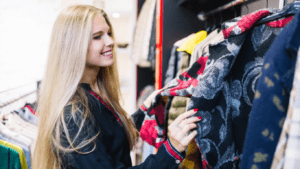Introduction:
Millions of women worldwide wear the hijab to express their religious identity and style. Fashion particularly hijab fashion has moved toward sustainability in recent years. The idea of Hijabhoojup mixes traditional hijab-wearing with current ecological practices. We explore how hijab fashion may be fashionable and culturally relevant while employing eco-friendly materials ethical manufacturing processes and local craftspeople.
Understanding Sustainable Fashion

Sustainable fashion prioritises environmental and social responsibility in apparel creation. The garment’s lifespan includes raw material sourcing production distribution and disposal. Sustainability in hijab fashion includes using biodegradable ethically sourced and environmentally friendly materials. It also promotes fashion industry transparency and fair labor.
The Importance of Sustainable Choices in Hijab Fashion
Sustainable hijab fashion is important for several reasons. Fashion is a major polluter and trash producer. Consumers may lessen their environmental impact by using sustainable products and activities. Second sustainable hijab fashion ensures fair labor and fair pay. Finally, sustainability may inspire new hijab designs that combine traditional and contemporary trends appealing to a wider audience.
Sustainable Materials for Hijabs

The sustainable hijab trend depends on material choice. Traditional cotton and silk manufacturing practices are being reconsidered. Organic cotton cultivated without pesticides and fertilizers is greener. Recycled textiles like polyester from plastic bottles are also trendy.
Organic Cotton: A Preferred Choice
Hijab manufacture works well with organic cotton. It uses less water and no hazardous chemicals than ordinary cotton. Organic cotton is hypoallergenic and excellent for sensitive skin since it is chemical-free. Many businesses now offer organic cotton hijabs in many shapes and colors letting women express themselves while being sustainable.
Bamboo Fabric: The Eco-Friendly Option
Hijab fashion also uses bamboo cloth another ecological solution. Bamboo is ecologically beneficial since it grows quickly and needs little water. Bamboo fibres are soft breathable and antimicrobial making them excellent for hijabs. Biodegradable bamboo cloth won’t end up in landfills.
Ethical Production Practices

Hijab fashion sustainability requires ethical manufacturing and sustainable resources. This involves paying fair wages providing safe working conditions and preventing exploitation. Supporting local artists and small businesses may also help support fashion.
The Role of Local Artisans
Local craftspeople are crucial to sustainable hijab fashion. Consumers can maintain traditional crafting processes and ensure ethical and ecologically sustainable manufacturing by supporting these talented people. Many local artists employ traditional techniques that consume fewer resources reducing their carbon impact. Buying directly from craftsmen empowers communities and economies.
Transparency in the Fashion Supply Chain
Promoting fashion ethics requires transparency. Consumers are more conscious of where and how their clothes are created. Supply chain openness builds consumer confidence. Fair Trade and GOTS certifications help shoppers select ethical and sustainable businesses.
Sustainable Fashion Trends in Hijab Styles

Growing desire for sustainable hijab fashion drives eco-friendly trends. Designers are mixing contemporary and old designs to create sustainable collections. This section discusses sustainable hijab fashion trends.
Minimalist Designs
Minimalist hijab designs are popular in sustainable fashion. Simple designs that value quality over quantity decrease waste and promote thoughtful consumption. Minimalist hijabs are wardrobe staples due to their neutral hues and adaptable shapes. This method encourages sustainability and suits individuals who desire a more subdued style.
Upcycled and Recycled Fabrics
Upcycled and recycled textiles are another fascinating sustainable hijab trend. Many designers now make hijabs from fabric scraps or reused clothes decreasing waste and material use. This novel technique protects the environment and delivers distinctive designs that stand out among mass-produced solutions.
The Impact of Social Media on Sustainable Hijab Fashion

Social media influences consumer behavior and sustainable fashion. Influencers and campaigners are raising hijab fashion sustainability awareness on Instagram and TikTok. They promote eco-friendly businesses and encourage mindful decisions.
Building a Community of Sustainability Advocates
Social media can unite sustainable fashion enthusiasts. Online communities may encourage sustainable behaviour promote eco-friendly companies and debate sustainability. By connecting sustainability advocates the hijab fashion community can have a bigger effect.
Raising Awareness Through Storytelling
Many hijab fashion influencers employ storytelling to emphasise sustainability. They may motivate others to use sustainable products by sharing their stories. Sustainability is humanized and customers are encouraged to think critically about their purchases.
Conclusion:
Hijabhoojup shows that sustainable hijab fashion is vital and good for society and the environment. The hijab fashion business may promote sustainability by stressing eco-friendly materials ethical manufacturing and new designs. As consumers, we can make educated fashion choices that promote sustainability.
FAQs:
What is Hijabhoojup?
Hijabhoojup is a sustainable and eco-friendly hijab fashion trend. It promotes local craftspeople’s sustainable materials and ethical manufacture. Hijabhoojup designs beautiful eco-friendly and socially concerned hijabs.
Why is sustainability important in hijab fashion?
Hijab fashion must be sustainable since the fashion industry pollutes waste and exploits workers. Consumers can limit their environmental effects support fair labor and promote a sustainable fashion future by selecting sustainable materials and ethical manufacturing processes.
What materials are considered sustainable for hijabs?
Hijabs made of organic cotton bamboo linen and recycled polyester are sustainable. Bamboo is fast regenerative and organic cotton is pesticide-free. Recycled polyester from plastic bottles reduces landfill waste. These materials are eco-friendly comfortable and stylish.
How can I identify sustainable hijab brands?
Sustainable hijab companies have Fair Trade or Global Organic Textile Standard certifications. Research the brand’s material sourcing manufacturing and labor methods. Sustainable companies also disclose their supplier networks to help customers choose.



